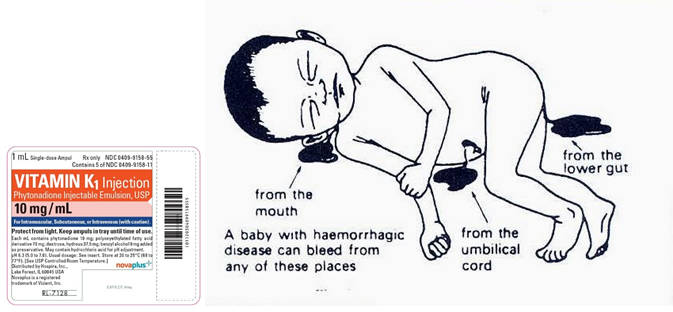The father of a newborn asks the practical nurse (PN) why an injection is being given to his baby. Which response by the PN best explains the purpose of administering Phyto menadione injectable to newborns?
Promotes maturation of the lungs.
Aids in digestion and milk absorption.
Prevents hemorrhagic disease.
Controls hyperbilirubinemia.
The Correct Answer is C
Phyto menadione injectable, also known as vitamin K1, is commonly given to newborns to prevent hemorrhagic disease of the newborn (HDN), a bleeding disorder that can occur due to vitamin K deficiency in the first few days of life. Vitamin K is important for the production of clotting factors in the liver, and newborns are at risk of vitamin K deficiency because it does not cross the placenta well and their intestinal flora is not yet established. The other options do not accurately describe the purpose of administering Phyto menadione injectable to newborns.

Nursing Test Bank
Naxlex Comprehensive Predictor Exams
Related Questions
Correct Answer is C
Explanation
The PN should provide the information that it may be helpful to **try withholding fluids after supper and before bedtime**. Bedwetting is common and often runs in families. It can be upsetting, but most children and young people will grow out of it³. It’s not unusual for kids to wet the bed at night. Known formally as pediatric enuresis, uncontrolled nighttime urination affects as many as 5% to 10% of 7-year-olds in the United States.
Correct Answer is C
Explanation
Iron supplements are often recommended for pregnant women to prevent or treat anemia and to improve the iron status of both the mother and the baby ¹. During pregnancy, you need 27 milligrams of iron a day ². Iron is also found in some foods, such as meat, beans, and leafy greens ¹. So, it is recommended to increase dietary iron-rich foods.

Whether you are a student looking to ace your exams or a practicing nurse seeking to enhance your expertise , our nursing education contents will empower you with the confidence and competence to make a difference in the lives of patients and become a respected leader in the healthcare field.
Visit Naxlex, invest in your future and unlock endless possibilities with our unparalleled nursing education contents today
Report Wrong Answer on the Current Question
Do you disagree with the answer? If yes, what is your expected answer? Explain.
Kindly be descriptive with the issue you are facing.
